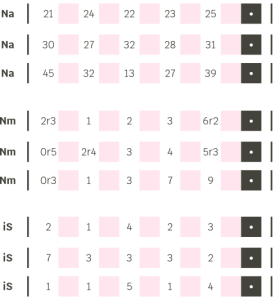Sound sets
Succession and collection are two different ways of grouping musical elements of the same type. We call these groupings sets of elements and they have different applications.

The succession serves to order the musical elements in time and the collection serves to make different groupings of elements without a specific order.
Sound succesions are sets of elements of the same type (or Notes, or iS, or iA), in a specific order. They organize the sound information, since each succession has an expressive intention. The elements of the sound succesions can be written in modular or absolute numbering.
Let’s look at different examples of successions:

The collection is a type of set that contains elements of the same type, without a successive order in time. The elements of the sound collections can be written in modular or absolute numbering. The scale and the chord are examples of sound collections.
From collections we can select elements, specify their order and create succesions; let’s see some examples:
 |
 |
The function of a sound collection of notes, or iS, is to create intervallic structures that can generate natural scales or artificial scales.
A sound cell is defined from a given sequence of between two and six iS.
As we have seen, the abstract nature of the iS allows us to apply them to any note and in any direction we want (ascending and descending), and it is the same with a succession of iS.
When creating a sound cell we are marking an iS pattern that defines a certain contour. Sound cells can be transposed to different notes, repeated, and used in different contexts. Let’s take a look at some examples:

As we can see, cells can be used to develop new compositional material or even to structure entire sections of our composition. The sound cells together with the rhythmic cells build the melodic motives. Sometimes a rhythmic and sonorous cell can become a melodic motif; other times, it is the succession of several cells that make it up.

